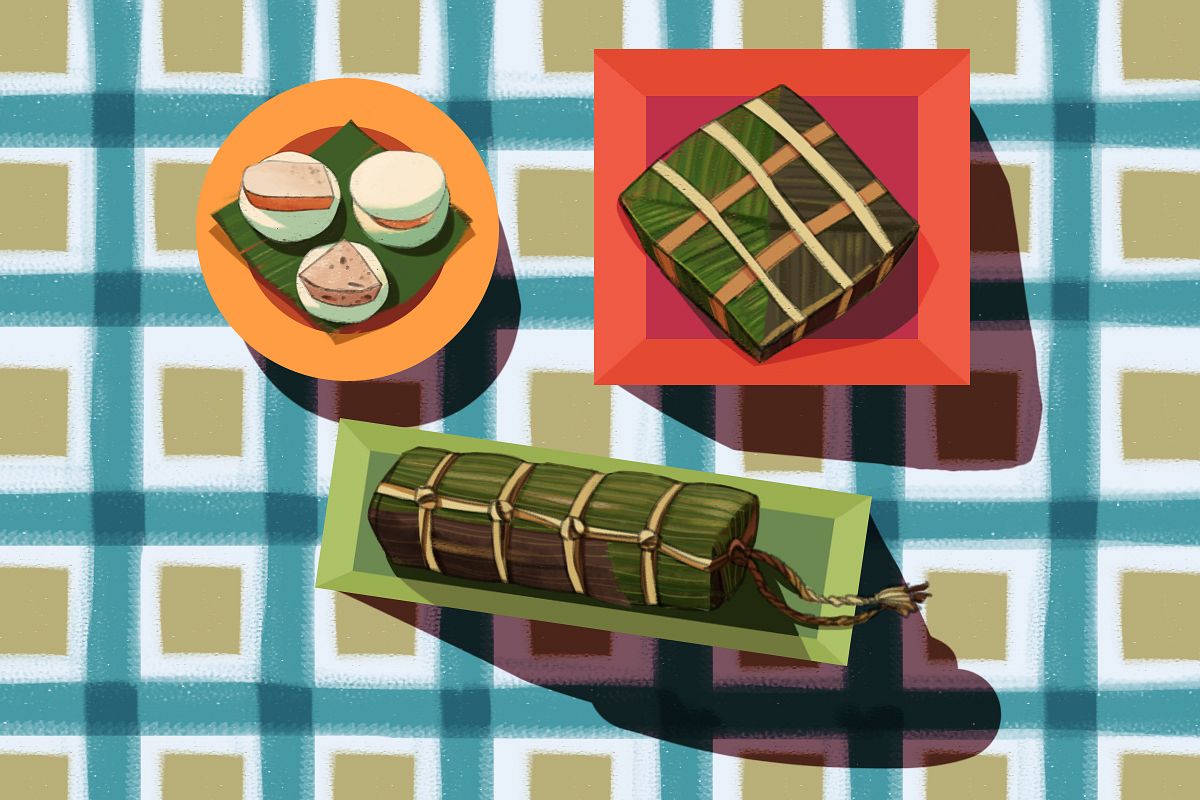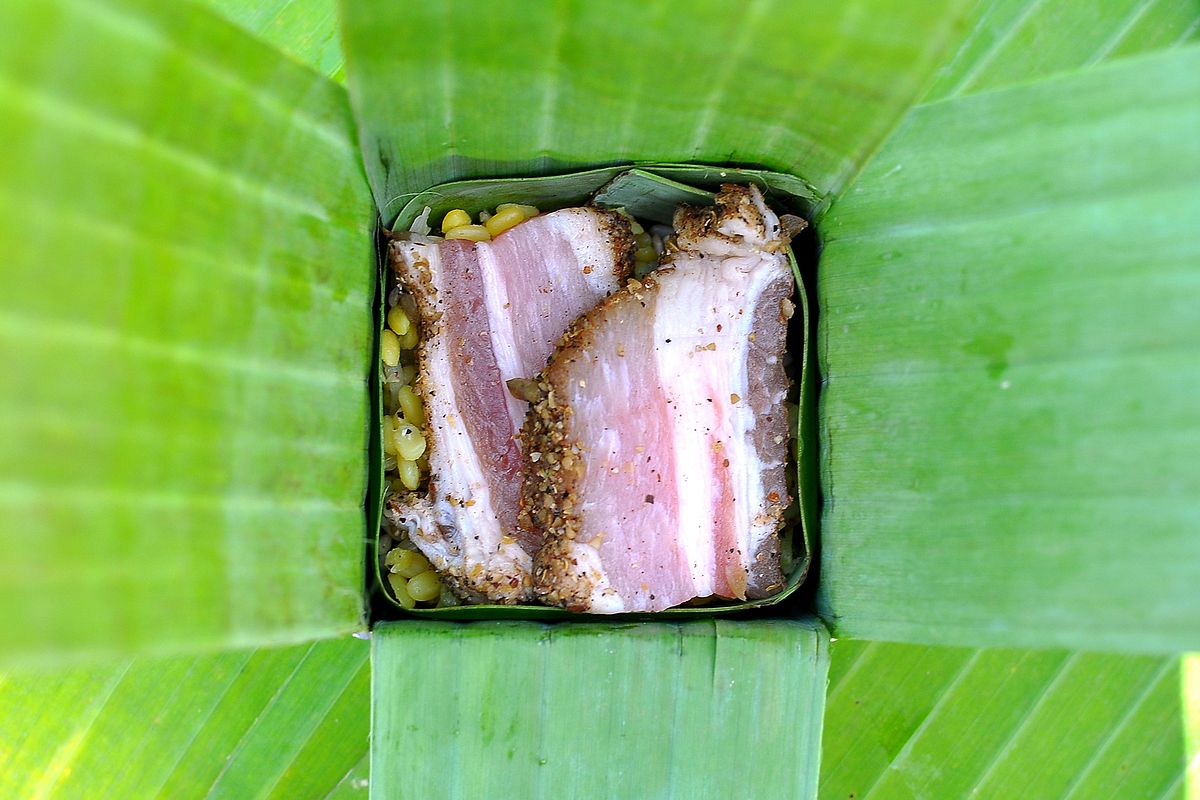To me, there's nothing that screams Tết as much as sticky rice cake. However one wants to spice up the usual celebration by replacing some dishes with something new each year, sticky rice cakes remain a must-have in Vietnamese households. Try searching for an image of the Lunar New Year and there’s a high chance that you’ll spot the cakes amongst the first ten results.
Vietnam's culinary repertoire features several types of sticky rice cakes. Bánh chưng and bánh giầy are most commonly associated with families from the northern provinces. Bánh chưng refers to a savory square cake made of sticky rice with mung bean paste and pork filling, wrapped in lá dong, an oval-shaped leaf. Bánh giầy is a white sticky bun made from glutinous rice often served with giò chả,a type of Vietnamese sausage.
Then there’s bánh tét, which is mostly eaten in central and southern Vietnam. The savory filling of bánh tét is similar to that of bánh chưng, except it's cylindrical and wrapped in banana leaves. However, there are different versions including a sweet one with banana fillings; bánh tét lá cẩm, with magenta plant-infused sticky rice; bánh tét trà cuôn, which is a spin-off from the original pork filling with salted egg and dried shrimp added for more flavors.
Bánh chưng & bánh giầy
The origins of the sticky rice cakes are equivocal. Although there are no reliable factual accounts of it, the earliest record of bánh chưng bánh giầy can be found in Book 1 of Lĩnh Nam Chích Quái (Extraordinary Stories from Lĩnh Nam), the earliest collection of legends, myths, and folklore dating back to ancient Vietnam in the 14th century, compiled by an anonymous author during the Trần dynasty. Most of the stories in the collection are an attempt to explain many aspects of Vietnamese life, including the origins of iconic foods like paan or watermelon. The bánh chưng bành giầy story, titled “Chưng bính truyện” is the one with which most people are familiar.
“Chưng bính truyện” tells the story of the sixth Hùng King who wants to pick an heir amongst his 20 sons. To do this, the king hosts a cooking competition among the brothers, sending them on a search for delicious dishes everywhere in the world. Lang Liêu, the king’s eighteenth son, being poor and motherless, couldn’t afford to travel far. Lucky for the prince, one night when Lang Liếu is sleeping, a deity enters his dream and is kind enough to offer Lang Liêu the advice to use sticky rice as the main ingredient to make a square cake (bánh chưng), symbolizing the earth; and a round cake (bánh giầy), symbolizing heaven. According to the deity, there is no exotic delicacy that can compare with rice, as rice feeds and nurtures life. The deity also adds the leaf wrapping to represent a mother's protection. Lang Liêu follows the suggestion and becomes the heir.
Although the story is obviously not a factual account, it’s interesting how symbolic meanings of cosmology, nutritional logic, and a unified sense of national and cultural identity are packed into a single narrative that is widely used as an explanation for a very concrete and mundane item.
Sociologist and anthropologist Nir Avieli breaks down these meanings in his culinary ethnography on the Tết rice cakes in Hoi An. For example, the square and round shape as representations for earth and heaven, to be offered during Tết, a time that is considered by many a rebirth of nature, can be seen as performing a symbolic creation and recreation of the universe.
Avieli continues to ponder the legend's emphasis on rice that reflects the rice-growing agriculture of Vietnam. It can also be understood as a way of infusing geographies and national identity into the cake's meaning. Although Vietnam is not the only country that thrives on rice cultivation, it sure is an identity-defining trait of the country. The cake, according to Avieli, also resembles a spatial organization of the countryside, where rice farms (the sticky rice layer) can be found anywhere with small patches of legumes and other farm animals nearby.
However, given the legend's heavy dose of magical elements, the story raises doubts and debates among some Vietnamese scholars. In his essay “Triết lý bánh chưng bánh giầy” (The philosophy of bánh chưng bánh giầy), historian Trần Quốc Vượng contends that the story of Lang Liêu is more of a “fakelore” rather than an authentic Vietnamese folk story as the idea of using square and round objects as symbols for earth and heaven is an imported cultural conception from China's cosmology.
Bánh tét
As for the central and southern bánh tét counterpart, we are left with fewer legends to discuss, yet its factual origins and history remain a debate among many. Some believe that the cylindrical treat is an invention originating from a military tactic of turning bánh chưng into bánh tét to more easily to carry around as a combat ration. The idea is credited to King Quang Trung (Nguyễn Huệ) in his campaign against the Manchu army in December 1789. However, there are many versions of this story. For example, another narrative suggests that it was one of Quang Trung's soldiers who brought bánh tét from his hometown to Quang Trung to be used as a dish for Tết and victory celebration. Another way to look at bánh tét is through the prevalence of rice-farming anxiety during Tết, which used to be a vulnerable time for crops. Because it can be stored for a long time the cake is, therefore, a practical means of overcoming food spoilage.
The most eye-opening theory for bánh tét origins — one that crushed my former assumption that the sticky rice cakes are exclusive to Vietnamese culture – belongs to Tran Quoc Vuong. He suggests that the dish might be the remnants of the past Champa kingdom and was only exposed to Vietnamese people during Nam tiến, a period when Vietnam expanded its territory southward and occupied Champa.
Indeed, bánh tét, or taipei nung in Chăm language, is an important traditional dish in many Chăm festivals including Kate (Cham Balamon community's new year) and Ramawan (Cham Awal community's new year). In this context, bánh tét now contains different meanings that relate to phồn thực, which is a faith followed by Chăm people that celebrates life and reproduction. Phồn thực worships linga (the phallic icon) and yoni (a symbol for the womb). A common food combination in a Kate festival is bánh tét and sakaya (a type of ginger-based cake that has a dendritic shape), representing the linga and yoni, respectively. As a common Chăm saying goes: peinung ala, sakaya ngaok (bánh tét placed below, sakaya cake placed above).
Of course, we should take all these tales with a grain of salt. Apart from giving us insights into the history of the food itself, they also reveal a history of how people attach meanings to food which attempt to negotiate and maintain a consistent cultural and national identity. They are, in a sense, the stories we tell ourselves about ourselves as an expression of identity and senses of belonging via mundane objects.
This article was originally published in 2018.

















